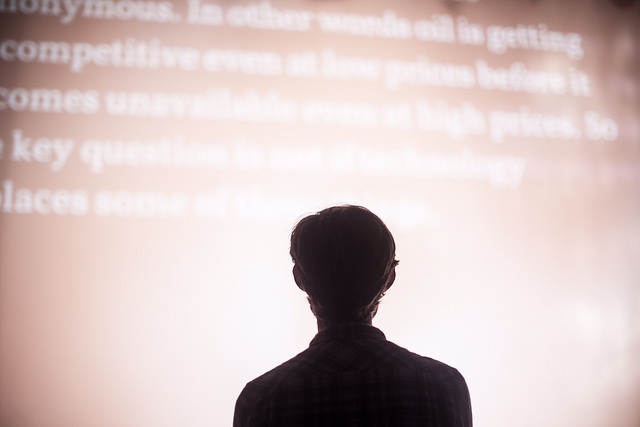Creative Data Mining Diamonds in Dystopia An Interactive Poetry Web Application
Main Article Content
Abstract
One of the most popular new media platforms for the proliferation and distribution of ideas related to Technology, Entertainment, and Design is produced in the form of TED Talks. For the independent TED event—designated by the x—TEDxLSU, three media artists developed a poetry performance web app, Diamonds in Dystopia, which applies advanced coding techniques to aggregate TED Talk transcripts as found text to generate new stanzas using a found text and Markov chains creative process, which enables succinct recombination of massive amounts of language as source material. This addition pushes the boundaries of the TED Talk by adding another exciting and popular form of new media, interactivity, to the mixture of mediums. Performance-scaled interactivity, specifically using mobile devices in an audience comprised of hundreds of users swaps the individualized information dissemination system and turns it into one capable of creative output or collaboration. The collaborative text contributed by the audience in Diamonds in Dystopia further engages information dissemination because the user’s interaction enables a parallel creative bond to form between the audience experience and the performing poet, in terms of the text methodology employed. By picking or clicking on the individual word selections of a seed poem that resonate with them, audience members create Markov chain reactions that creatively recombine and datamine a database of over 2,500 TED Talks to send a flurry of improvisational stanzas to the poet, which he then improvises into the poem on stage, creating and archiving an event-specific version of the poem and performance.
Article Details

This work is licensed under a Creative Commons Attribution-ShareAlike 4.0 International License.
References
Benjamin Bratton “We need to talk about TED”TheGuardian, December 30, 2013. Accessed January 30, 2017,https://www.theguardian.com/commentisfree/2013/dec/30/we-need-to-talk-about-ted.
Charles O. Hartman, Virtual Muse: Experiments in ComputerPoetry, 1st edition (Hanover, NH: Wesleyan, 1996), 1.
Daniel C. Howe, “RiTa: Creativity Support for Computational Literature” (ACM Press, 2009), 205, doi:10.1145/1640233.1640265.
Golan Levin et al., “Dialtones (A Telesymphony)” (Ars Electronica, Linz, Austria, September 2001), https://www.theguardian.com/commentisfree/2013/dec/30/we-need-to-talk-about-ted.
John Cage and Kyle Gann, Silence: Lectures and Writings, 50th Anniversary Edition, 2 edition (Middletown, Conn: Wesleyan, 2011), 4.
John Cage and Kyle Gann, Silence: Lectures and Writings, 50th Anniversary Edition, 2 edition (Middletown, Conn: Wesleyan, 2011), 11.
Joseph Watson, “Screening TED: A rhetorical analysis of the intersections of rhetoric, digital media, and pedagogy.” PhD dissertation, Louisiana State University, 2014. https://www.theguardian.com/commentisfree/2013/dec/30/we-need-to-talk-about-ted.
Lev Manovich, “How to Compare One Million Images?,” inUnderstandingDigitalHumanities, ed. D. Berry, 2012 edition (Houndmills, Basingstoke, Hampshire; New York: Palgrave Macmillan, 2012), 250.
Roberto Simanowski, Digital Art and Meaning: Reading Kinetic Poetry, Text Machines, Mapping Art, and Interactive Installations (Minneapolis: University of Minnesota Press, 2011), 113.



